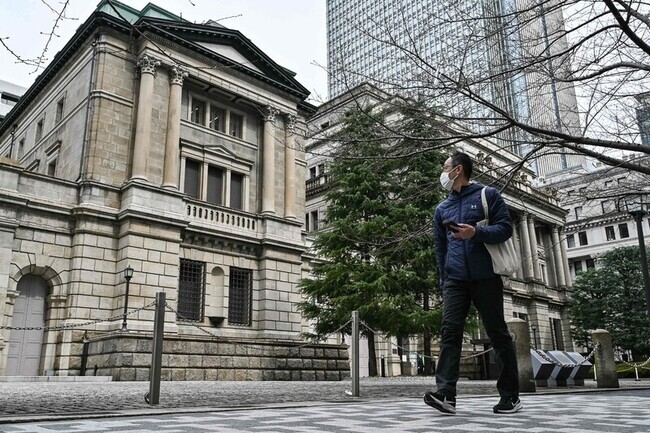hankyoreh
Links to other country sites 다른 나라 사이트 링크
Is a 1,300-plus won-to-dollar exchange rate Korea’s new normal?

The won-dollar exchange rate has just hit another yearly high. Needless to say, the depreciation of the won is no cause for celebration.
The unexpectedly strong American economy and uncertainty about when the US Federal Reserve will lower interest rates are behind a strong dollar that’s driving down the won.
But the strength of the dollar isn’t the only factor behind the rising won-dollar exchange rate. Even more important are changes in the domestic and international conditions that are impacting the Korean economy. We should recall that the exchange rate reflects the economic fundamentals.
The first thing to note is that weakness in the won has been accompanied by weakness in the yen and the yuan.
The Bank of Japan has made a policy pivot, ending years of negative interest rates, but the yen-dollar exchange rate is above 150 yen once again as the yen proves weaker than expected.
While the weak yen is due in part to the Bank of Japan’s decision to maintain an accommodative monetary policy through continuing purchases of government bonds, another factor is the Japanese government and central bank’s tolerance for a weak yen.
Simply put, Japanese policymakers apparently don’t mean to stop sustaining the yen’s unusual weakness — which they deem essential for putting the Japanese economy back on a stable track.
China also appears to be tolerant of a weak yuan. Beijing is keeping the yuan from getting too weak, but approves of its basic condition. That’s apparently connected with the effort to turn exports into a driver for growth, as the Chinese economy struggles to overcome weak domestic demand.
Another apparent reason the Chinese government is tolerant of weakness in its currency is so that it can boost export competitiveness for industries such as electric vehicles and secondary cells, which are at the heart of its strategy of “high-quality development.”
We’re not at the point where we should interpret the weakness of the yen and yuan as representing beggar-thy-neighbor policies, but it’s undeniably having a quite negative impact on the Korean economy and industry. The yen-won exchange rate is seemingly fixed just below 900 won (per 100 yen), which is exerting small but persistent pressure on the Korean economy.
Domestic factors are another reason for the weak won. Despite an apparent recovery in Korea’s export market, the business cycle in sectors other than semiconductors and shipbuilding is not showing signs of a recovery. In addition to that, the downturn in the domestic market is worse than expected.
The burden of inflation, the burden of debt during a protracted period of high interest rates, and a prolonged downturn in the real estate market are exacerbating a slump in domestic demand. Even the credit risk is on the rise.
While the rumors about a crisis erupting in April due to real estate project financing woes have been somewhat allayed by proactive liquidity policies put in place by Korea’s government, it remains to be seen just how long it will take for domestic business conditions to make a full recovery. A look at domestic trends alone makes it hard to conclude that the won-dollar exchange rate won’t go up any further.
It may well be that rates in the 1,300-1,350 won to the dollar range are the new normal for exchange rates. But amidst this transition period in which interest rate policies are shifting across the globe, countries are further strengthening industrial policy toward supply-side economics in order to protect and foster their own cutting-edge industries.
These policy shifts could trigger major changes in the exchange rates for some of the world’s major economies. If Korea doesn’t jump on the bandwagon of global policy trends to secure its competitiveness, it could run the risk of a hard-to-predict surge in the won-to-dollar exchange rate.
By Park Sang-hyun, economist at Hi Investment & Securities
Please direct questions or comments to [english@hani.co.kr]

Editorial・opinion
![[Column] Life on our Trisolaris [Column] Life on our Trisolaris](https://flexible.img.hani.co.kr/flexible/normal/500/300/imgdb/original/2024/0505/4817148682278544.jpg) [Column] Life on our Trisolaris
[Column] Life on our Trisolaris![[Editorial] Penalties for airing allegations against Korea’s first lady endanger free press [Editorial] Penalties for airing allegations against Korea’s first lady endanger free press](https://flexible.img.hani.co.kr/flexible/normal/500/300/imgdb/original/2024/0502/1817146398095106.jpg) [Editorial] Penalties for airing allegations against Korea’s first lady endanger free press
[Editorial] Penalties for airing allegations against Korea’s first lady endanger free press- [Editorial] Yoon must halt procurement of SM-3 interceptor missiles
- [Guest essay] Maybe Korea’s rapid population decline is an opportunity, not a crisis
- [Column] Can Yoon steer diplomacy with Russia, China back on track?
- [Column] Season 2 of special prosecutor probe may be coming to Korea soon
- [Column] Park Geun-hye déjà vu in Yoon Suk-yeol
- [Editorial] New weight of N. Korea’s nuclear threats makes dialogue all the more urgent
- [Guest essay] The real reason Korea’s new right wants to dub Rhee a founding father
- [Column] ‘Choson’: Is it time we start referring to N. Korea in its own terms?
Most viewed articles
- 1New sex-ed guidelines forbid teaching about homosexuality
- 260% of young Koreans see no need to have kids after marriage
- 3[Column] Life on our Trisolaris
- 4OECD upgrades Korea’s growth forecast from 2.2% to 2.6%
- 5Presidential office warns of veto in response to opposition passing special counsel probe act
- 6Months and months of overdue wages are pushing migrant workers in Korea into debt
- 7[Guest essay] Maybe Korea’s rapid population decline is an opportunity, not a crisis
- 8Trump asks why US would defend Korea, hints at hiking Seoul’s defense cost burden
- 9[Editorial] Penalties for airing allegations against Korea’s first lady endanger free press
- 10Japan says it’s not pressuring Naver to sell Line, but Korean insiders say otherwise